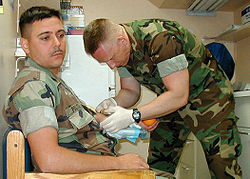Prior to the establishment of the Hospital Corps, enlisted medical support in the Navy was limited in scope. In the Continental Navy and the early U.S. Navy, medical assistants were assigned at random out of the ship’s company. Their primary duties were to keep the irons hot and buckets of sand at the ready for the operating area. It was commonplace during battle for the surgeons to conduct amputations and irons were used to close lacerations and wounds. Sand was used to keep the surgeon from slipping on the bloody ship deck. Previously, Corpsman were commonly referred to as a Loblolly boy, a term borrowed from the British Royal Navy, and a reference to the daily ration of porridge fed to the sick. The nickname was in common use for so many years that it was finally officially recognized by the Navy Regulations of 1814. In coming decades, the title of the enlisted medical assistant would change several times—from Loblolly Boy, to Nurse (1861), and finally to Bayman (1876). A senior enlisted medical rate, Surgeon’s Steward, was introduced in 1841 and remained through the Civil War. Following the war, the title Surgeon’s Steward was abolished in favor of Apothecary, a position requiring completion of a course in pharmacy.
A Hospital Corpsman draws blood from a patient as part of his duties as an independent duty Corpsman
Still, there existed pressure to reform the enlisted component of the Navy’s medical department—medicine as a science was advancing rapidly, foreign navies had begun training medically skilled sailors, and even the U.S. Army had established an enlisted Hospital Corps in 1887. Navy Surgeon General J.R Tyron and subordinate physicians lobbied the Navy administration to take action. With the Spanish-American War looming, Congress passed a bill authorizing establishment of the U.S. Navy Hospital Corps, signed into law by President William McKinley on 17 June 1898. Three rates were created therein — Hospital Apprentice, Hospital Apprentice First Class (a petty officer third class), and Hospital Steward, which was a chief petty officer.
A revision in 1916 established a new rate structure. With the introduction of a second junior rate there were now Hospital Apprentice Second Class (HA2c) and Hospital Apprentice First Class (HA1c). The rating title for petty officers was established as Pharmacist’s Mate (PhM), following the pattern of some of the Navy’s other ratings (boatswain’s mate, gunner’s mate, etc.). Pharmacist’s Mate Third Class (PhM3c), Second Class (PhM2c), and First Class (PhM1c) were now the petty officers, and Chief Pharmacist’s Mate (CPhM) was the CPO. This structure that would remain in place until 1947.
During World War I, hospital corpsmen served throughout the fleet, earning particular distinction on the Western Front with the Marine Corps. A total of 684 personal awards were awarded to hospital corpsmen in the war, including 2 Medals of Honor, 55 Navy Crosses, and 237Silver Stars.
In World War II, hospital corpsmen hit the beach with Marines in every battle in the Pacific. Joe Rosenthal‘s iconic photo of the flag-raising on Iwo Jima, captured during that battle’s early days, depicts Pharmacist’s Mate Second Class John Bradley among the group of Marines on Mt. Suribachi that day. They also served on thousands of ships and submarines. Notably, three unassisted emergency appendectomies were performed by hospital corpsmen serving undersea and beyond hope of medical evacuation. The Hospital Corps has the distinction of being the only corps in the U.S. Navy to be singled out in a famous speech by Secretary of the Navy James Forrestal after the conclusion of the war.[3] Following the war, the Hospital Corps changed its rating title to the generic term it had used all along — Hospital Corpsman. The rates of Hospital Corpsman Third Class (HM3), Second Class (HM2), and First Class (HM1), and Chief Hospital Corpsman (HMC) were supplemented by Senior Chief Hospital Corpsman (HMCS) and Master Chief Hospital Corpsman (HMCM) in 1958.
Hospital corpsmen continued to serve at sea and ashore, and accompanied Marine units into battle during the Korean and Vietnam wars. Fifteen hospital corpsmen were counted among the dead following the bombing of the Marine barracks in Beirut in 1983. Today, hospital corpsmen are serving in the Iraq and Afghanistan wars providing corpsmen for convoys, patrols, and hospital or clinic treatment.
Prior to selection to the Command Master Chief program, the 11th MCPON, Joe R. Campa, was a Hospital Corpsman.

